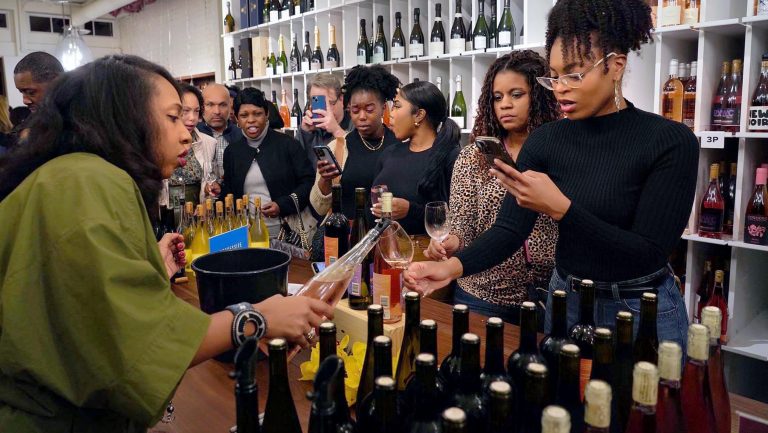In our new series, 5 Bottles I Sold Last Night, sommeliers and wine directors talk about the bottles that they’re selling, giving tips and context for making the sale.
At The Bachelor Farmer, we focus on Northern Hemisphere, cooler-climate wines from small grower-centric wineries. The wine menu matches the sentiment of our cool-region cuisine. We’re a go-to spot for wine enthusiasts of all stripes, from neophytes to serious drinkers—and our chalkboard program has been a big part of that.
Here’s how it works: We offer guests the chance to purchase half a bottle from our list of approximately 100 full bottles, and then we write the remaining two glasses on a big chalkboard as being up for grabs. The idea is to offer guests the opportunity to try wines they may never have heard of without the pressure of committing to an entire bottle. It’s interactive and fun, as glass options change throughout the evening. Additionally, it lets guests try several wines during their meal, which can really elevate a table’s dining experience.

Don’t miss the latest drinks industry news and insights. Sign up for our award-winning newsletters and get insider intel, resources, and trends delivered to your inbox every week.
The chalkboard program also allows us to sell full bottles that we perhaps wouldn’t have otherwise sold. Here are five bottles I sold last night (the prices listed are what we charge at the restaurant):
1. Domaine Overnoy-Crinquand Arbois-Pupillin Ploussard; Jura, France 2013; $70 full bottle; $35 half bottle
I like to pour this for Burgundy lovers who want to try something new. This wine is made in the village of Pupillin—which is recognized as the home of the Ploussard grape—on 5.5 hectares of organically tended vines in limestone and clay soils. It’s lighter bodied with high acid, and has good earthy notes with an almost barnyard characteristic—a little funky. For the right Burgundy drinker, it’s a fun adventure into something different.
2. ArPePe Sassella Stella Retica Valtellina Superiore Riserva; Lombardy, Italy 2010; $110 full bottle, $55 half bottle
This Nebbiolo doesn’t have the same aging requirements as a traditional Barbaresco or Barolo, so it’s perfect for a restaurant because it’s approachable young. It’s delicious and fresh, and also a lot more accessible price-wise. We sometimes serve a dish called pizzoccheri, a traditional Valtellinesi buckwheat pasta with cabbage and potatoes. We lead with the dish and then introduce the wine.
3. Jean Bourdy Côtes du Jura Blanc; Jura, France 2010; $56 full bottle; $28 half bottle
This wine is the backbone of our list. It’s 100 percent Chardonnay, farmed organically in Arlay, naturally fermented, and aged in old barrels for years before bottling, so it has a nutty characteristic. Chardonnay can be tough—we have guests with preconceived notions about how it should taste. But we just put a little splash in front of them and hope to change their minds. If we ask permission, it can make them wonder, “Am I paying for this?” So we just do it. The staff is so behind this bottle of wine that they’re recommending it every night. We even have guests who call back days after their dinner and ask us what it was they drank and where to get it.
4. Ott Grüner Veltliner Am Berg; Wagram, Austria 2015; $48 full bottle; $24 half bottle
Guests are curious about Austrian wine when they see it on our list, and often this biodynamic stunner will be their first taste of one. We even have a few Austrian guests who come in and pound bottles of this wine, which is the highest form of validation! It’s a real crowd pleaser, with flavors of stone fruit and a little white pepper, and it finishes dry. It pairs well with difficult foods like asparagus, green beans, or cauliflower. It’s really versatile and inexpensive. Grüner is a somm’s best friend in a lot of ways.
5. Domaine Huet Vouvray Demi-Sec Le Mont; Loire Valley, France 2007; $84 full bottle; $42 half bottle
I like Chenin Blanc with little sweetness, so I’m pouring Huet’s demi-sec at the moment. It has an incredible richness and goes really well with our food, which is simple and can have lot of fat. This wine is a real showstopper, with high acid and a lot of fruit, so it really holds up to protein. It’s a great way to change people’s minds about drinking white wine with a meat-focused entrée.
—As told to Blane Bachelor

Dispatch
Sign up for our award-winning newsletter
Don’t miss the latest drinks industry news and insights—delivered to your inbox every week.
Erin Rolek is the general manager and sommelier at The Bachelor Farmer in Minneapolis. She was chosen as Food & Wine’s 2017 Sommelier of the Year.







